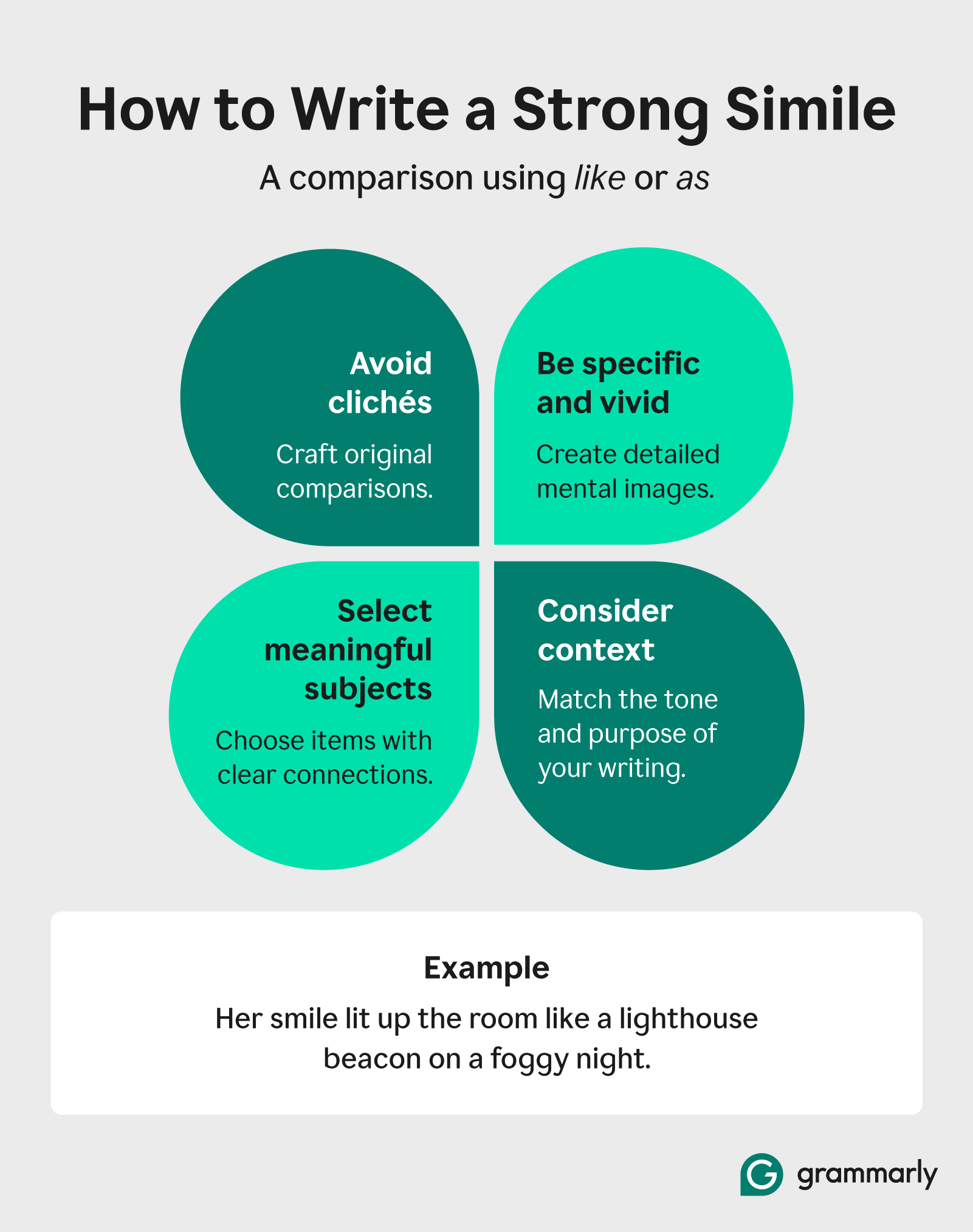
Key takeaways:
- A simile is a literary device that compares two different things using the words like or as.
- Similes make writing more engaging and relatable by helping readers visualize concepts through familiar comparisons.
- An example of a simile is “the water was as clear as glass.”
“My momma always said, ‘Life was like a box of chocolates—you never know what you’re gonna get.’” This iconic line from Forrest Gump shows what similes do best: use like or as to create expressive, memorable comparisons.
Similes make ideas easier to understand by relating them to something familiar. Instead of saying someone runs fast, we say they “run like the wind.” Rather than just calling someone quiet, we might say they’re “as quiet as a mouse.”
In this post, we’ll examine the art of the simile, explaining how it works and how to use it to make your writing more vivid.
Table of contents
How to create effective similes
Simile vs. other literary devices
What is a simile?
A simile (SIM-uh-lee) is a comparison that uses like or as to describe something by comparing it to something else. Writers use similes for more relatable, precise descriptions.
Even if you don’t know the definition like the back of your hand, you’ve probably seen plenty of similes. For example:
- I know that definition like the back of my hand.
- Those two are as different as night and day.
- He stood out like a sore thumb.
- That answer is as clear as mud.
- Grandpa has a memory like a sieve.
Why do we use similes?
Similes create vibrant mental pictures by comparing something to something else using like or as (as in “her smile was as bright as the sun”). They help readers instantly visualize descriptions and can make your writing more engaging.
Similes simplify complex ideas by linking them to familiar things. For example, comparing a cheetah’s speed to something exceptionally fast, like a sports car.
Types of similes
Similes make ideas clearer and more defined, whether in everyday conversation or creative writing. Below are some common types, with examples to show how versatile they can be.
Direct similes
Direct similes make straightforward comparisons using as or like. They’re simple and instantly recognizable.
Implied similes
Implied similes suggest a comparison without stating it outright, relying on context and imagery. They often feel more subtle or poetic.
Extended similes
Extended similes, which stretch across multiple lines or sentences and are more elaborate, are common in literature and storytelling.
Metaphor similes
Metaphor similes blend simile and metaphor by using like or as in a symbolic way rather than a literal comparison.
Antithesis similes
Antithesis similes pair opposites in a comparison to emphasize contrast or irony. They often reveal surprising truths or highlight contradictions.
Personification similes
These similes give human traits and behavior to objects, natural elements, or animals through comparison, often adding emotional depth.
Uses of similes
Similes make language more vivid and engaging. They clarify ideas, stir emotion, and add style—helping readers and listeners connect with characters, arguments, and settings more easily. Below are some effective ways writers and speakers use similes.
Descriptive
Descriptive similes paint a clear picture of someone or something by comparing it to a well-known image or experience.
- As sharp as a knife
- Like a breath of fresh air
- As cold as ice
Expressive
These similes help convey deep feelings, adding emotional weight to what might otherwise be a simple statement.
- As angry as a hornet
- Like a feather caught in the wind
- As sad as a rainy day
Animal
Animal similes compare people or situations to animals to quickly convey traits like speed, hunger, or energy. They’re common in everyday speech and easy for anyone to understand.
- As busy as a bee
- Like a squirrel chasing its tail
- As hungry as a bear
Literary
Literary similes are more artful and elaborate, often found in poetry, prose, or plays. They can evoke deeper meaning, emotion, or imagery.
“Is love a tender thing? It is too rough, Too rude, too boist’rous, and it pricks like thorn.” — Romeo and Juliet, William Shakespeare
“Does it dry up Like a raisin in the sun? Or fester like a sore— And then run?” — “Harlem,” Langston Hughes
“I wandered lonely as a cloud that floats on high o’er vales and hills.” — “Daffodils,” William Wordsworth
Common simile examples
Below are common similes to show how these comparisons work in everyday language:
Common simile examples
| Simile | Meaning |
| As brave as a lion | Extremely courageous |
| Like a needle in a haystack | Something very difficult to find |
| As free as a bird | Free or unrestricted |
| Like a fish out of water | Uncomfortable or out of place |
| As fast as a cheetah | Moves with exceptional speed |
| Like a deer in headlights | Frozen in fear or confusion |
| As cool as a cucumber | Calm and relaxed under pressure |
| Like a kid in a candy store | Displays excitement and eagerness |
| As strong as an ox | Very strong |
| Like watching paint dry | Extremely boring or slow |
| As cute as a button | Something or someone is adorable and charming |
| Like two peas in a pod | Two things are very similar or closely connected |
| As flat as a pancake | Very flat |
| Like birds of a feather | Similar in character or behavior |
| As hungry as a horse | Extremely eager to eat |
Similes and exaggeration
Exaggeration in similes helps to emphasize a particular quality or trait by comparing it to something extreme or impossible. This makes the comparison more striking and memorable. Here are some examples that show how exaggeration works:
Exaggeration example sentences
| Example sentence | Explanation |
| He runs as fast as lightning. | Emphasizes speed through exaggeration |
| They’re as sweet as honey. | Highlights sweetness with a common, relatable exaggeration |
| You sing like a bird. | Elevates the quality of singing, suggesting perfection |
Exaggerating through similes helps create stronger images that draw readers in and make descriptions more dynamic.
How to create effective similes
Similes can make your writing more interesting and easier to understand—if you use them well. A strong simile helps readers picture what you mean by comparing it to something familiar.
These tips will help you write better similes, whether you’re writing a story or poem, or merely want to describe something more clearly. You’ll also find a helpful diagram below to guide you in creating strong comparisons.

1 Choose clear comparisons
A simile should compare two things that have something obvious in common. If the connection isn’t clear, your reader might get confused.
For example, “He ran like lightning” makes sense because both are fast. But “He ran like a whisper” is harder to understand—what do running and whispering have in common?
2 Avoid clichés
Clichés are similes people overuse, like “cold as ice” or “busy as a bee.” These phrases are easy to understand, but they’ve been used so much that they no longer feel fresh or interesting.
Try to come up with your own comparisons. A new simile will make your writing stand out and feel more personal.
3 Use rich sensory details
The best similes help readers see, hear, or feel what you’re describing. That’s where sensory details come in, things like:
- Sight
- Sound
- Touch
- Smell
- Taste
Instead of saying, “Her laugh was like sunshine,” try something more specific: “Her laugh was like the warm glow of the sunset on a summer evening.” This paints a clearer picture and helps the reader feel what you mean.
Similes vs. other literary devices
Understanding the differences between similes and other similar figurative language can help you recognize comparisons in writing and use them more effectively.
Metaphor
Similes and metaphors make comparisons or explain concepts, but they aren’t the same:
- Simile: Compares two things using like or as.
- Metaphor: Directly states that one thing is another.
Here are a few examples to show the difference:
Metaphor vs. simile examples
| Similes | Metaphors |
| Life is like a box of chocolates. | My life is an open book. |
| That baby is as cute as a button! | Baby, you’re a firework. |
Understanding the difference between a simile and a metaphor can improve your ability to recognize and use figurative language in your writing.
Analogy
Like similes, analogies also make comparisons, but in a more detailed way. A simile uses like or as for a quick comparison, while an analogy explains how two things are similar to help someone understand an idea better. Here are a few examples to show the difference:
Metaphor vs. analogy examples
| Similes | Analogy |
| Learning a new language is like climbing a mountain. | Learning a new language is like climbing a mountain. It takes time and effort, and the higher you go, the more you understand. |
| Writing a story is like running a marathon. | Writing a story is like running a marathon. Finishing takes a lot of time, energy, and focus. |
While both are useful comparison devices, similes offer quick, creative comparisons for emotional impact, whereas analogies break down complex ideas through specific similarities for clearer understanding.
Wrapping up your simile skills
With practice, using similes effectively can bring your writing to life. By focusing on originality and clarity, you’ll craft meaningful and memorable comparisons. Keep refining your simile skills to make your writing even more impactful.
Level up your writing with Grammarly
Write with clarity and confidence. Grammarly can help you polish your writing, including your use of similes, ensuring your message is strong and mistake-free. Get started with Grammarly today.
Simile FAQs
Here are common questions about writing similes correctly to help improve your comparisons.
How do you write a simile?
To write a simile, compare something hard to describe with something easier to understand. Use the words like or as to show the similarity between the two. For example, “Like a diamond in the rough” compares something with hidden potential to an unpolished diamond, helping to paint a clearer picture.
Why should you use a simile in a sentence?
A simile helps make writing clearer and more engaging by comparing one thing to something familiar using like or as. It adds creativity and emotion to your writing. For example, “The wind howled like a wolf” creates a stronger image than just saying, “The wind was strong.”
What are common mistakes to avoid when using similes?
Using similes effectively can add dynamics to your writing. However, avoid these common mistakes:
- Avoid clichés and overused comparisons: Phrases like “as busy as a bee” are overdone and fail to make an impact. Instead, aim for fresh, original comparisons that bring your writing to life.
- Make sure the comparison is logical and clear: The connection between the two things should be easy to understand and help clarify the description, not confuse the reader.






